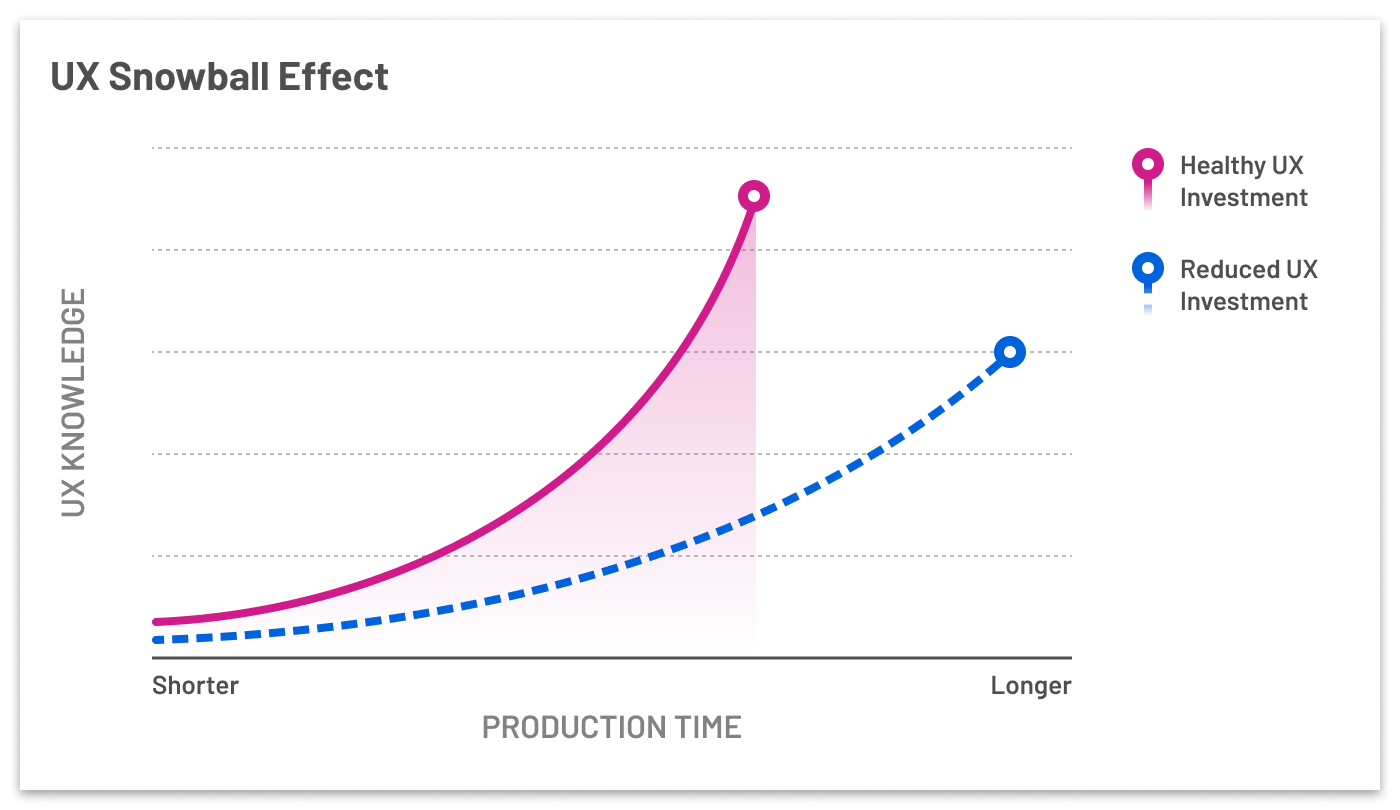As an EdTech leader, you know firsthand how challenging it can be to strike the right balance between production costs, time to market, and quality. You must ship great products that generate revenue for your bottom line, build customer confidence in your brand, and ensure that your user and business needs are adequately addressed. That’s a pretty tall order, especially considering that you’re probably also under pressure to tighten your proverbial belt, given the current economic times.
As a result, you may be grappling with the inevitable need to trim production costs in the form of UX research, design, and engineering. That option looks particularly appealing to many organizations when revenue is down, outlooks are murky, and markets are volatile (2020, anyone)? It’s true that cutting production may yield a short-term financial benefit. But without careful consideration, this approach isn’t just short-term; it’s also short-sighted.
What You Risk When You Cut Your UX Research, Design, and Engineering Budgets
By cutting production costs, you put your product at risk in two ways.
The first has to do with the quality of your finished product. When you whittle down production costs in an attempt to fix a revenue problem, you risk underinvesting in UX research, design, and production. The result? An underbaked final product that doesn’t meet users’ needs, let alone wow them.
Second, cutting production costs may paradoxically lead to fewer savings than you think — and could even lead to reduced revenue. That’s because a smaller production investment usually means a longer development timeline. Think about it: Cutting costs equals shedding resources. Depending on your situation, that might mean fewer teams, individuals, external partners, tools, or a combination of all of the above.
With fewer resources at hand, your remaining team’s output will inevitably slow down. The longer they work, the longer you keep spending — while at the same time paying the opportunity cost of a delayed launch. In the end, you’ll almost certainly find yourself trading lower costs for lower revenue.
If your EdTech company has a revenue problem, your best bet is to remove as many barriers to speed and success as possible. And the only way to do that is by refusing to cut corners. You must follow the UX research and testing protocols that enable your team to confidently design the right product — and build it right, too.
Investing in Your UX Strategy Equals Faster Time to Market
You might assume that taking your UX investment down a notch would equal a speedier development time. Won’t you take your product to market faster with fewer rounds of research and testing along the way?
It’s true. When you commit to a healthy UX investment, you incorporate extra pieces and moving parts in the form of research and testing. However, investing appropriately in UX — whether maintaining your current team or even increasing output — can still significantly reduce your time to market. Think of it as a “UX snowball effect.”

As your UX team conducts research, your team quickly learns exponentially more about your users than you otherwise would. That knowledge will enable your team to make more confident decisions about your product. Over time, that knowledge and confidence snowballs on itself. Previous rounds of research inform the next rounds of research, and those findings in turn lead the way to smarter design decisions. In addition, with research in hand, everybody on your team can more quickly identify priorities and get on board with new decisions.
With the proper funding, a right-sized team, and a well-planned course of research, your entire product development process will pick up steam and more rapidly cross the finish line.
Finally, hastening your production process with a UX snowball is the only risk-free way to speed up your time to market. Unlike cutting corners, there’s nothing sloppy about it. By leveraging the efficiency and accuracy that a good UX team ensures, you can move faster without any risk of “haste makes waste.”
Right-Sizing Your UX Investment Requires Understanding Risks
In a perfect world, your EdTech company would never face pressure to cut production costs. But in the real world, your business faces certain dictated realities — realities that may mean pruning costs. The good news? Your UX investment doesn’t have to be perfect in order to reap benefits. And the right UX partner can help guide you in determining what your planned investment will get you — and what risks you face.

Seasoned chess players know that if they place a pawn in a given spot, they can expect a particular set of consequences. And they weigh each move based on that broader understanding. Similarly, your UX partner should be able to tell you how a given level of investment might impact your product development timeline and outcomes. For example, downsizing your UX team might make it harder for them to stick to your engineering team’s schedule. And in terms of outcomes, if your releases don’t speak to user needs as well as they used to, you risk introducing a long tail of confidence erosion among your user base.
At Openfield, we work with product leaders like you to identify the ideal level of investment for your particular projects. But we can also help you figure out how best to engineer the investment you can commit to in order to achieve maximum impact. As we discuss possible investment levels, we can guide you in weighing the options and identifying ways to mitigate your risks. Like a chess player, we see all the various pieces and know how they fit together. As a result, we can help you understand what it will mean to pull various levers, thus enabling you to make the best decision for your business — and your product.
Interested in learning more about how Openfield can help your EdTech company right-size your UX investment? We’d love to talk.
